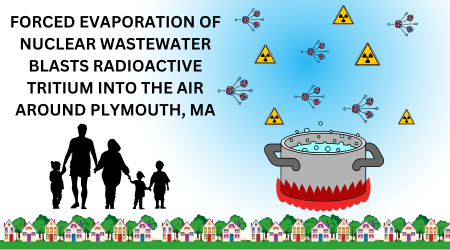Decommissioning Corporation Boils Off Radioactive Wastewater After Citizens Thwart Their Plans to Dump it Into Cape Cod Bay
- By Christopher Nord, Amesbury, MA
- •
- 07 Sep, 2023
Tritium is a radioactive byproduct of nuclear fission, found in abundance in nuclear wastewater. The Cape Cod community wants to be safe from it, corporate industry and regulators want to dump into the air and water and forget it ever existed.

It recently came to light that Holtec has been using “forced evaporation” of radioactive water from the site of the closed Pilgrim atomic reactor in Plymouth. This action by Holtec, the private company who is being paid to decommission the nuclear plant, only came to light because of an August 18, 2023 letter from a whistleblower (excerpt below). The whistleblower declares this action is a “breach of trust,” and alleges that this evaporation tactic is Holtec’s response to not being able to simply dump the over 1-million-gallons of radioactive wastewater directly into Cape Cod Bay. That dumping plan was thwarted due to widespread public opposition and the Oceans Sanctuary Act, an anti-pollution state law in Massachusetts.


Contrary to how the atomic industry wants to “spin” Tritium, this is a dangerous radionuclide with a track record of adverse effects for humans. It is a Beta emitter, which means it can penetrate cell walls; and its 12-year half-life means that it is dangerous for a significant period of time. Ironically and tragically, our state’s residents became unwilling “guinea pigs” for an experiment in human exposure to Tritium in the second half of the last century, when the owners of the Yankee Atomic plant at Rowe dumped Tritium into the Deerfield River for decades. Because of local public outcry, this eventually led to a health study undertaken by the Massachusetts Department of Public Health, revealing statistically significant increases in Down Syndrome and Non-Hodgkins Lymphoma. Concerns over these findings were expressed to the Nuclear Regulatory Commission in a public hearing.
Clearly, Holtec has chosen to release this radioactive waste into the air because the State of Massachusetts and its citizens have effectively blocked the water-borne “dilute & dump” strategy that they intended. A July, 2023 draft-ruling from the state Department of Environmental Protection denied Holtec's requested permit to dispose of the waste into Cape Cod Bay. It is important to point out that, due to prevailing wind patterns, a lot of the radioactive molecules precipitating out of the vapor Holtec sends up will fall into the ocean—just the scenario prohibited by the Ocean Sanctuaries Act. The remaining radioactive particles may or may not drift beyond the state borders before falling back to earth.

Holtec pursues this environmentally dangerous path not because it is the best available way to safeguard our biosphere from these harmful compounds. The water and air pathways to dumping represent the least-cost avenues to rid themselves of the liability for all this radioactive water. Fully 17 years after the National Academies of Science finally acknowledged that there is no safe threshold below which radiation is not harmful, the NRC still permits the “dilute & dump” practices that our own best scientists have officially discredited. NRC regulations on the matter are long past due for updates commensurate with the most recently available science about organically bound tritium, bioaccumulation, and human health impacts.

What do we sacrifice in order
to allow these practices to continue? Human health, in particular that of children and women of child-bearing age, who are as much as twenty times more vulnerable to the
effects of radiation exposure as am I, an adult male—due to their relatively
high number of rapidly dividing cells. Combine this with
the greater efficiency
of radiation to cause cell damage at low doses, as well as the
extreme longevity of some radionuclides, and we have a recipe in place for
long-term biological degradation. All for the sake of keeping Holtec profits
up.
It is incumbent upon all of us to stop these obsolete and dangerous practices before they become so widespread as to be universally accepted. We do not want our great grandchildren to curse us for the choices we make—and the consequences they will suffer as the result.
Sources
1 “Reindeer are still very radioactive 30 years after Chernobyl”, Melia Robinson, Business Insider, December 2022
2 George A. Alexander, in Ciottone's Disaster Medicine (Second Edition), 2016
3 “Cancer Incidence and Down Syndrome Prevalence in the Deerfield River Valley, Massachusetts,” MDPH, BEHA, February, 1997 (not available online but excerpt cited in a 1994 NRC Hearing).
4 Drysdale, Sam. (2023, July 24). "State rejects effort to dump nuclear plant waste into Cape Cod Bay." CBS News.
5 Eyrolle, F., Copard, Y., Lepage, H. et al. Evidence for tritium persistence as organically bound forms in river sediments since the past nuclear weapon tests. Sci Rep 9, 11487 (2019). https://doi.org/10.1038/s41598-019-47821-1
6 “Biological Effects of Ionizing Radiation VII,” National Academies of Science, 2006
7 “The Petkau Effect”, Abram Petcau, 1972
© C-10 Research and Education Foundation 2025 C-10 is a registered 501(c)(3) nonprofit. Tax ID/EIN #22-3117209.



